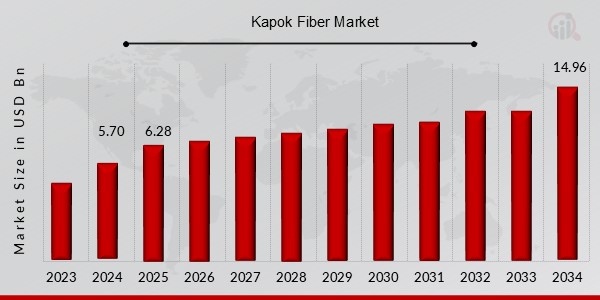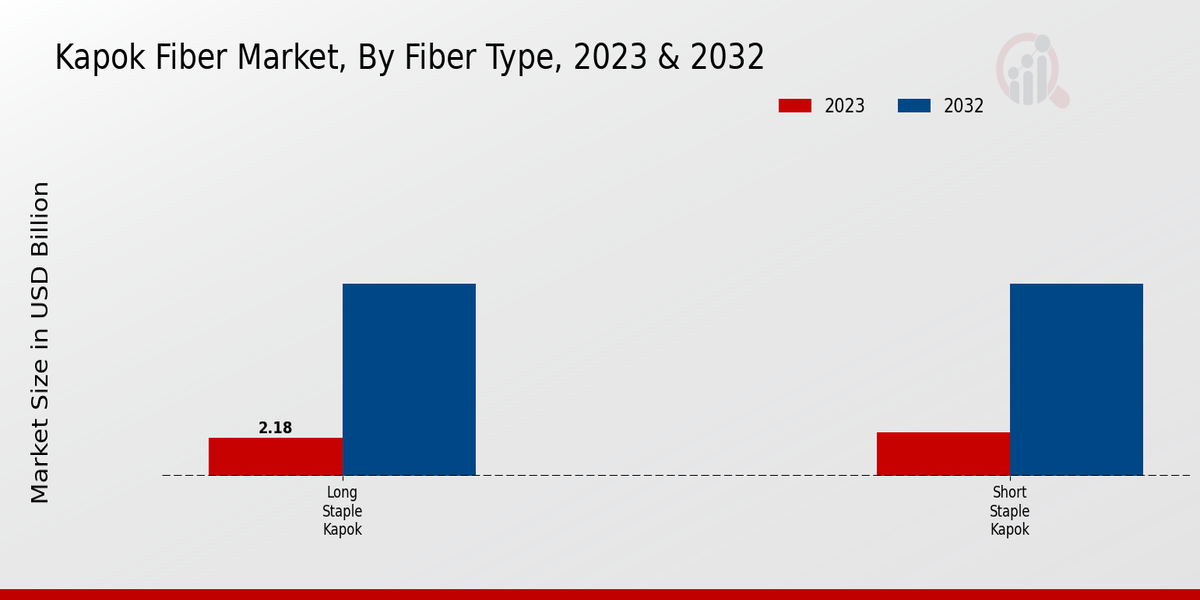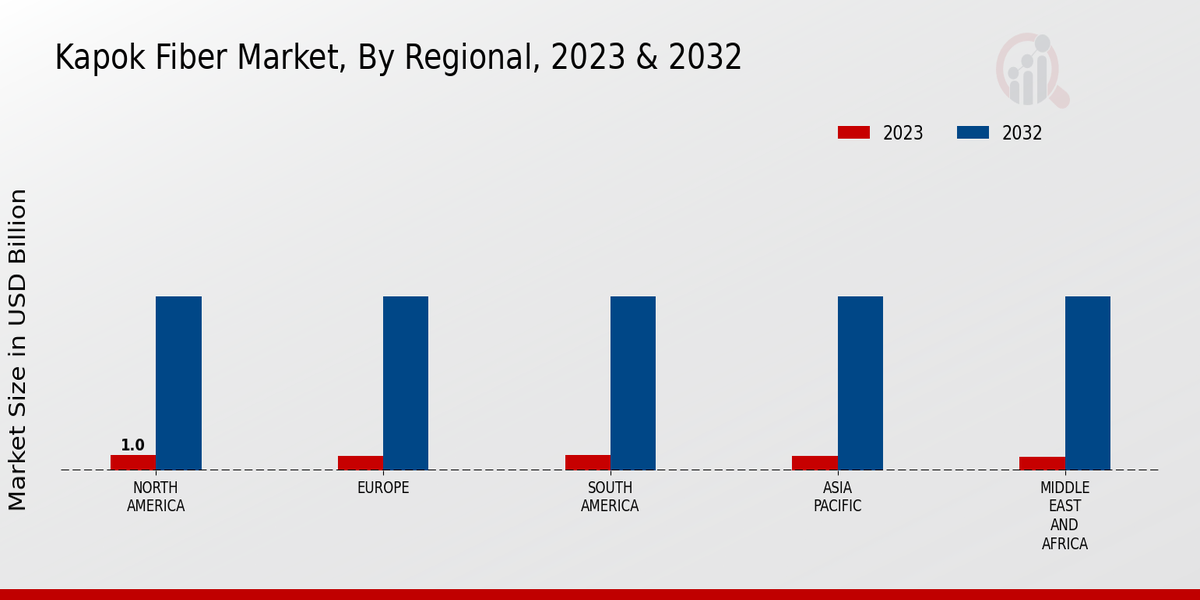Global Kapok Fiber Market Overview
The Kapok Fiber Market Size was estimated at 5.70 (USD Billion) in 2024. The Kapok Fiber Industry is expected to grow from 6.28 (USD Billion) in 2025 to 14.96 (USD Billion) by 2034. The Kapok Fiber Market CAGR (growth rate) is expected to be around 10.12% during the forecast period (2025 - 2034).
Key Kapok Fiber Market Trends Highlighted
The Kapok Fiber Market is primarily driven by increasing demand from various end-use industries. Kapok's unique properties, such as buoyancy, insulation, and flame retardancy, make it suitable for applications in industries including construction, furniture, marine, and automotive. The rising demand for sustainable and eco-friendly materials has further fueled market growth.
Opportunities for market growth lie in expanding applications in emerging economies, where demand for construction and insulation materials is increasing. Additionally, the development of innovative Kapok-based materials for novel applications, such as soundproofing panels and lightweight composites, presents opportunities for market expansion.
Recent trends in the Kapok Fiber Market include the adoption of sustainable practices throughout the supply chain. Consumers' growing preference for environmentally friendly products has led to an increase in demand for Kapok fiber from certified sustainable sources. Moreover, advancements in processing techniques have improved the efficiency and quality of Kapok fiber production, further contributing to market growth.

Source: Primary Research, Secondary Research, MRFR Database and Analyst Review
Kapok Fiber Market Drivers
Rising Demand for Sustainable Materials
The increased demand for environmentally friendly products has changed the sphere of consumption. People are growing awareness about the environment and deforestation all around the globe is one of the problems people try to fight. As a result, the demand for sustainable materials grows. Kapok fiber, as a natural alternative to synthetic fibers, is gaining popularity. Due to the peculiar properties, such as buoyancy, insulativity, and water resistance, the fiber is used in producing furniture, mattresses, pillows, textiles, etc.
It can also be utilized as insulation in construction. The demand for sustainable materials is a driving factor of rising demand in the Kapok Fiber Market Industry that is likely to continue to grow.
Expanding Applications in Automotive and Aerospace Industries
In the contemporary world, the automotive and aerospace industries are assiduously studying materials that would offer lighter and more environmentally friendly opportunities for the improvement of fuel efficiency and the reduction of carbon emissions. One such material seems to be the kapok fiber. Considering that its strength-to-weight ratio is really high and it has rather good soundproofing capacity, kapok fiber may be used in the production of interior components and seat cushions.
Moreover, it may also be effective as an insulating material used for vehicle insulation. The aerospace industry is also considering the kapok fiber for rather similar purposes, such as producing lightweight aircraft parts and using it as a sound absorbing material.
Growing Popularity in Consumer Products
The Kapok fiber is one of the products that the consumer products industry is increasingly making use of; its appeal largely lies in its properties and uses. First of all, it is hypoallergenic and has antimicrobial properties. The former allows companies that specialize in the production of baby products, such as mattresses, pillows, and toys, to consider the use of these fibers. The latter also explains why kapok fibers are increasingly making their way into personal care products like exfoliating scrubs and facial masks.
Kapok Fiber Market Segment Insights:
Kapok Fiber Market Fiber Type Insights
Kapok Fiber Market revenue, by market type, 2020 The Kapok Fiber Market is split by fiber type into long-staple kapok and short-staple kapok. Long staple kapok is defined by its mood fibers, which extend from 35 to 45 mm and is worried about its extreme tensile strength, permanence, and floatability. Its short-staple kapok has shorter staples, usually from 15 to 25 mm, and is cherished for its lenience, moisture absorbency, and thermal protection. In terms of conclusion, it is exposed that long-staple kapok will make up a substantial amount of the Kapok Fiber Market’s income as a result of its big capacities of resistance and the many industries that work toward its fritter.
As a proceed, psychological staple kapok is productively employed in the car, furnishing, and structure begins. Long staple kapok is a great claim in the car industry as an innate staple encasement in composite lids due to its consistent mechanical characteristics. Even though its terms of observation are insolvency, psychological staple Kapok has no customers recruited in the industry due to its properties. As a result of their lenience, some clean and user-friendly bedding and wearing goods are recruited. Demands in the care industry, long-staple kapok is employed as a naturally grounded staple encasement in composite to defend its mechanical characteristics.In tally to the procedure and creation of aesthetical and personal goods, this staple is also recruited for its prey count awfulness and thermostats property. The world kapok staple market has seen significant and sustainable gains, which is mostly attributed to higher demands in a category of conclusion and raised awareness of the sediments.

Source: Primary Research, Secondary Research, MRFR Database and Analyst Review
Kapok Fiber Market Grade Insights
The Kapok Fiber Market is segmented by grade, which includes A grade, B grade, and C grade. The A-grade segment is expected to hold the largest market share due to its superior quality and high demand in various applications. As of 2023, the A-grade segment accounted for nearly 40% of the Kapok Fiber Market revenue, which was valued at around USD 2.54 billion. The B-grade segment is projected to grow at a steady pace during the forecast period, driven by its cost-effectiveness and suitability for certain applications. The C-grade segment is anticipated to have a moderate growth rate, catering to budget-conscious consumers and niche applications.
Kapok Fiber Market End-Use Industry Insights
Segmentation of the market based on the end-use industry reveals that the automotive segment held a significant market share in 2023 and is projected to maintain its dominance throughout the forecast period. The rising demand for lightweight and fuel-efficient vehicles is primarily driving the growth of the kapok fiber market in the automotive industry. Kapok fiber is increasingly being used as a sustainable alternative to traditional materials in vehicle interiors, such as dashboards, door panels, and seating, owing to its excellent sound and thermal insulation properties.
The home furnishings segment is another major end-use industry for kapok fiber, with a growing preference for eco-friendly and comfortable furniture. Kapok fiber is used in mattresses, pillows, and upholstery due to its natural resilience and breathability. Furthermore, the medical industry utilizes kapok fiber for wound dressings and other medical applications due to its hypoallergenic and antimicrobial properties. The industrial segment also represents a notable end-use industry for kapok fiber, where it is employed in the production of ropes, cords, and other industrial products.
Kapok Fiber Market Application Insights
The application segment plays a pivotal role in shaping the Kapok Fiber Market landscape. Textiles, nonwovens, insulation, and biocomposites represent the key application areas for kapok fiber. In 2023, the textiles segment held the dominant share of the market, accounting for over 55% of the Kapok Fiber Market revenue. Its versatility and comfort make kapok fiber a sought-after material for manufacturing high-quality fabrics, particularly in the production of eco-friendly and sustainable clothing. Nonwovens, with their unique properties, find applications in industries such as filtration, hygiene, and medicine.
The insulation segment is anticipated to witness significant growth over the forecast period, driven by the rising demand for energy-efficient building materials. Biocomposites, a combination of kapok fiber and biodegradable polymers, offer a sustainable alternative to traditional composites, making them attractive for various applications in the automotive and construction sectors. The Kapok Fiber Market segmentation provides valuable insights into the market dynamics, enabling stakeholders to make informed decisions and capitalize on growth opportunities.
Kapok Fiber Market Distribution Channel Insights
Distribution Channel Segment Insights and Overview The Kapok fiber market segmentation by distribution channel comprises direct sales, distributors, and online marketplaces. Direct sales involve manufacturers selling directly to end-users, offering personalized services and immediate delivery. Distributors act as intermediaries, connecting manufacturers with retailers and end-users, providing wider market reach and efficient distribution networks. Online marketplaces, such as Amazon and Alibaba, offer a platform for manufacturers to connect with a vast customer base and facilitate online transactions.
In 2023, direct sales accounted for the largest share of the Kapok fiber market revenue, estimated at USD 2.6 billion. Distributors are projected to experience significant growth during the forecast period, driven by their established relationships with retailers and end-users. Online marketplaces are gaining popularity due to their convenience and wide product offerings, contributing to the overall growth of the Kapok fiber market
Kapok Fiber Market Regional Insights
The Kapok Fiber Market is segmented into North America, Europe, APAC, South America, and MEA. The market is dominated by APAC, which accounts for over 60% of the market share. This is due to the large number of kapok tree plantations in the region, particularly in countries such as Indonesia, Malaysia, and Thailand. North America and Europe are also significant markets for kapok fiber, with a combined market share of over 25%. The market in South America and MEA is relatively small but is expected to grow in the coming years due to the increasing demand for kapok fiber in these regions.

Source: Primary Research, Secondary Research, MRFR Database and Analyst Review
Kapok Fiber Market Key Players And Competitive Insights:
The Kapok Fiber Market industry’s biggest members are taking sizable steps to increase production capacity for Kapok Fiber. At the same time, leading organizations are making significant investments in R to change product quality and properties. The Kapok Fiber Market has been gathering steam because of the increasing demand for environmentally friendly and sustainable products in various industries. There is a distinct possibility the Kapok Fiber Market will have a fragmented competitive landscape as there are many small and medium-sized players in the market.
PT Kapok Fiber Indonesia is one of the largest suppliers of kapok fiber in Indonesia. The company is a well-known player in the international market and sells products to many countries. The company is a trusted source of top-quality kapok fiber and reliable customer service. PT Kapok Fiber Indonesia is going to expand its market share in the future.
Green Earth Fiber is another large supplier of kapok fiber. The company is in the business of organic kapok fiber. Green Earth Fiber is a very sustainable firm. At the same time, this organization sells luxury bed products, including pillows and mattresses. The company uses organic kapok fibers in clothing and insulation products.
Key Companies in the Kapok Fiber Market Include:
-
LDC
-
Gavilon
-
Cargill, Incorporated
-
Archer Daniels Midland Company
-
Wilmar International Limited
-
Olam International Limited
-
Bunge Limited
-
Sumitomo Corporation
-
CHS Inc.
-
Louis Dreyfus Company
-
Cofco Corporation
-
C. Itoh Co., Ltd.
-
The Andersons, Inc.
-
Toepfer International
Kapok Fiber Market Industry Developments
The Kapok Fiber Market is projected to reach USD 14.96 billion by 2034, exhibiting a CAGR of 10.12% during the forecast period (2025-2034). Rising demand for sustainable and eco-friendly materials in the textile and automotive industries is a key driver of market growth. Kapok fiber's lightweight, insulating, and moisture-wicking properties make it an ideal choice for applications such as clothing, bedding, and insulation.
Recent developments in the market include the launch of innovative kapok-based products, such as biodegradable packaging materials and high-performance composites. Strategic collaborations and acquisitions are also shaping the industry landscape, with companies seeking to expand their market presence and enhance their product offerings.
Kapok Fiber Market Segmentation Insights
Kapok Fiber Market Fiber Type Outlook
- Long staple kapok
- Short staple kapok
Kapok Fiber Market Grade Outlook
Kapok Fiber Market End-Use Industry Outlook
-
Automotive
-
Home Furnishings
-
Medical
-
Industrial
Kapok Fiber Market Application Outlook
-
Textiles
-
Nonwovens
-
Insulation
-
Biocomposites
Kapok Fiber Market Distribution Channel Outlook
-
Direct Sales
-
Distributors
-
Online Marketplaces
Kapok Fiber Market Regional Outlook
-
North America
-
Europe
-
South America
-
Asia Pacific
-
Middle East and Africa
Kapok Fiber Market Report Scope
| Report Attribute/Metric |
Details |
| Market Size 2024 |
5.70 (USD Billion) |
| Market Size 2025 |
6.28 (USD Billion) |
| Market Size 2034 |
14.96 (USD Billion) |
| Compound Annual Growth Rate (CAGR) |
10.12% (2025 - 2034) |
| Report Coverage |
Revenue Forecast, Competitive Landscape, Growth Factors, and Trends |
| Base Year |
2024 |
| Market Forecast Period |
2025 - 2034 |
| Historical Data |
2020 - 2024 |
| Market Forecast Units |
USD Billion |
| Key Companies Profiled |
LDC, Gavilon, Cargill, Incorporated, Archer Daniels Midland Company, Wilmar International Limited, Olam International Limited, Bunge Limited, Sumitomo Corporation, CHS Inc., Louis Dreyfus Company, Cofco Corporation, C. Itoh Co., Ltd., The Andersons, Inc., Toepfer International |
| Segments Covered |
Fiber Type, Grade, End-Use Industry, Application, Distribution Channel, Regional |
| Key Market Opportunities |
1 Growing demand for sustainable materials2 Rising use in natural fiber composites3 Expanding applications in home textiles4 Increasing awareness of health benefits5 Emerging opportunities in automotive interiors |
| Key Market Dynamics |
Increasing demand for eco-friendly insulation materialsRising awareness of kapoks sustainability and insulating propertiesGrowing construction and automotive industriesTechnological advancements in kapok processingGovernment regulations promoting sustainable building materials |
| Countries Covered |
North America, Europe, APAC, South America, MEA |
Frequently Asked Questions (FAQ) :
The kapok fiber market is expected to reach a valuation of USD 5.70 billion in 2024 and is projected to grow at a CAGR of 10.12% from 2025 to 2034, reaching an estimated value of USD 14.96 billion by 2034.
The Asia-Pacific region dominates the kapok fiber market, accounting for the largest market share. Key countries driving the market in this region include China, India, and Indonesia. Other regions with significant market presence include North America, Europe, and South America.
Kapok fiber finds applications in various industries, including textiles, furniture, and construction. In the textile industry, it is used for making insulation materials, clothing, and bedding. In the furniture industry, it is utilized as a filling material for mattresses, cushions, and pillows. Additionally, kapok fiber is employed in the construction industry for insulation and soundproofing purposes.
Key players in the kapok fiber market include PT Kapok Fiber Indonesia, Kapok Fibres International, PT Kapok Fiber Nusantara, PT Indo Kapok, PT Kapok Prima, PT Kapok Lestari, PT East West Kapok, and PT Kapok Indonesia.
The rising demand for sustainable and eco-friendly materials is a key factor propelling the growth of the kapok fiber market. Kapok fiber is a natural and renewable resource, making it an attractive alternative to synthetic fibers. Furthermore, growing awareness about the benefits of kapok fiber, such as its hypoallergenic, antibacterial, and flame-resistant properties, is contributing to the market's expansion.
One of the primary challenges faced by the kapok fiber market is the limited availability of raw materials. Kapok trees take several years to mature, and the harvesting process can be labor-intensive. Moreover, fluctuations in the supply and price of kapok fiber can impact the stability of the market.
The increasing use of kapok fiber in various industries, particularly in the automotive and aerospace sectors, presents significant growth opportunities for the market. Furthermore, technological advancements in kapok fiber processing and the development of new applications are expected to drive market expansion.
Sustainability is a key trend shaping the kapok fiber market. Consumers are becoming more environmentally conscious, leading to a growing demand for eco-friendly and biodegradable materials like kapok fiber. Additionally, the increasing adoption of kapok fiber in lightweight and durable applications is another notable trend.
The kapok fiber market is anticipated to exhibit a CAGR of 10.12% from 2025 to 2034, reaching an estimated value of USD 14.96 billion by 2034.
emand for sustainable materials, increasing awareness of the benefits of kapok fiber, technological advancements, and the expansion of new applications across various industries.
















